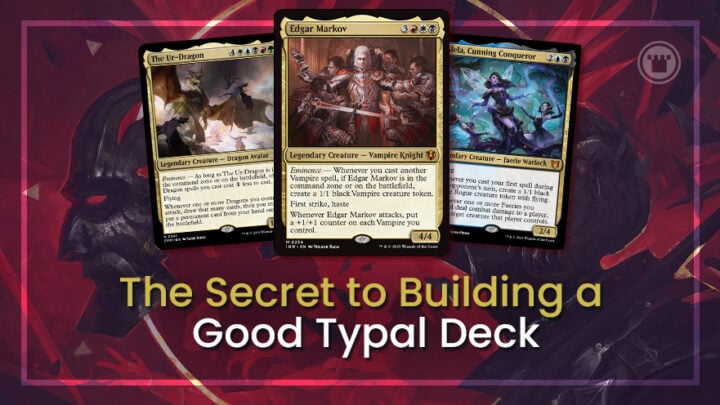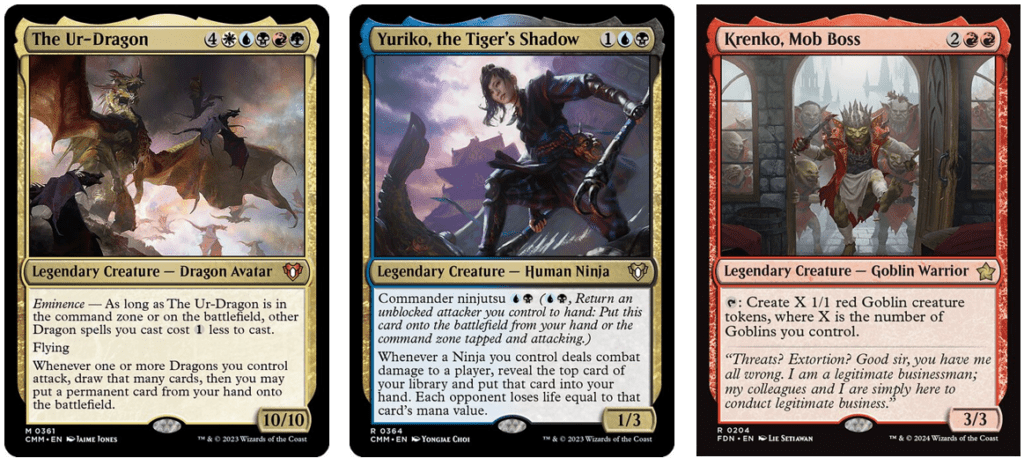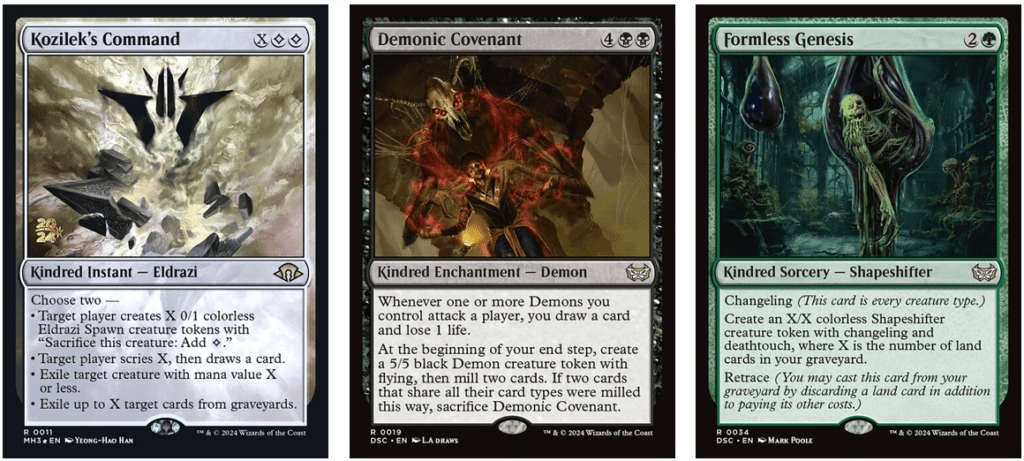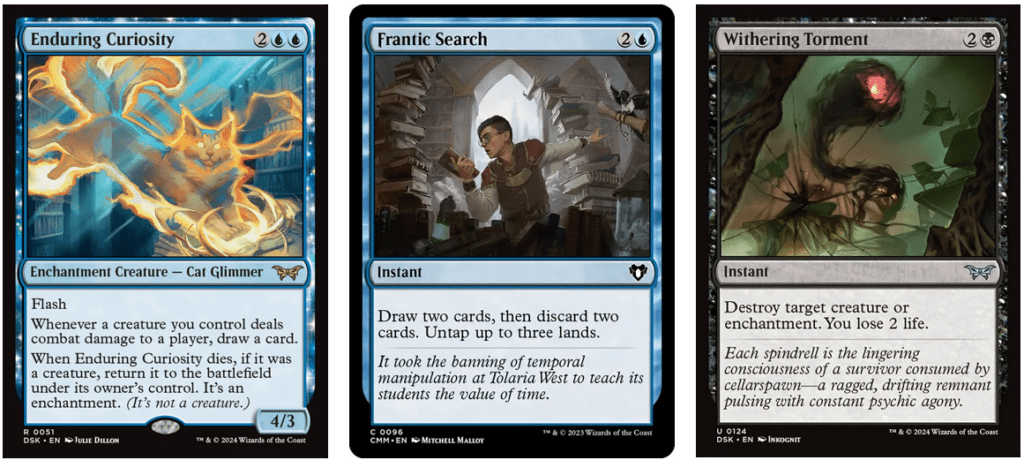Building a typal deck is a lot of fun – but how can you squeeze out the potential of the deck? What pitfalls can you avoid in deckbuilding? How do you build a good typal deck?
Typal decks are decks built around one creature type. It’s often a creature type people have a soft spot for, and it’s usually indicated by the Commander.
Some of the most popular Commanders of all time are typal decks, whether that’s Dragons, Ninjas, Goblins or Elves. They want you to either jam all of your creatures of your favored type, or make a bunch of tokens – or sometimes, both, which can be pretty potent.
One of the most popular precons of recent times is the Lhurgoyf themed Disa the Restless precon. It cares about Lhurgoyfs going to your graveyard, so yes – a card like Tarmogoyf Nest would work, which is really neat.
THE SECRET TO BUILDING A GOOD TYPAL DECK
I have a love-hate relationship with typal decks, I really do. I love them for their theme and flavor. There are few things cooler in Commander than building a typal deck with immaculate art and flavor throughout. Getting to run niche effects that play on the typal theme is even better – I love tutoring for Kindred Enchantments or instants with typal tutors (like Elvish Harbinger), or enjoying cost reduction or recursion on them due to being the same type as the creatures in your deck.
Where typal decks can fall down, however, is in the actual construction and gameplan departments. The thing with typal decks is that so much of the work is done for you on picking the cards – your lens is zoomed in on usually one creature type, and you can naturally assess which are the “better” cards in that type. You’ll go for Lords, or token makers, or card draw, for the most part. If you get some removal on legs, that’s a bonus.
Unlike when building a deck around a particular strategy, your gameplan in a typal deck might just be to curve out, with less thought put into how you get to a win. Building a deck around +1/+1 counters, or lifelink, for example, provides you with more mechanical synergy than just jamming all the cool Elves you love into a deck.
The secret to solving this is to approach a typal deck like any other build. You need to factor in your overall gameplan, the strengths and weaknesses of your deck, and the optimal number of effects to run. You need to decide when a generically “good” card – like a lord effect – doesn’t fit into your overall strategy as well as another effect you need.
Let’s examine some heuristics to adhere to, and look at some typal decks I run.
THIRTY IS THE MAGIC NUMBER
The first one to keep in mind, which I think many typal effects do succeed in hitting, is to ensure you have at least 30 typal creatures or ways to make those creatures in your build.
However, this should be viewed less as “I need 30 Elves or Vampires”, and more of “I need 30+ of whatever my deck is trying to do.” Because really, if your deck is trying to do anything in Commander as its main “thing”, then you need to see enough of it to work – especially when your Commander asks something of you. If your Commander says “whenever you do X”, then you better get down and give me at least thirty, son.
I recently built Alela, Cunning Conqueror. She’s an interesting one, because you can go deep on Faeries, or deep on casting in opponent’s turns… right? Well, actually, she pushes you far more into the latter. It’s nice to run plenty of Faeries too if that’s your jam, but she really wants you to be casting spells at instant speed.
My deck (over on Moxfield) has a total of 34 spells I can cast at instant speed, with the addition of Emergence Zone in the mana base. It has only 21 spells that make Faeries (aside from Alela herself) and Faerie Conclave in the manabase. Now, my goal for this deck was to build something decidedly mid-power, and leaning into the Faerie type (because I love Faeries). Whilst I’m running only 22 Faeries in the deck, I have over 30 ways of triggering Alela to make Faerie tokens.
Because I have over 30 ways to do this, my deck will feel like it accomplishes the thesis of my Commander – to cast in my opponent’s turns – most of the time. It can also make plenty of Faerie tokens to bolster up the typal payoffs. Speaking of which, I need to pick up a Banner of Kinship.
By running at least 30 of whatever I’m trying to do, then I can ensure my deck is consistent. That’s one foundation on which to build a gameplan.
Let’s look at another recent build.
IF YOU’RE NOT DRAWING CARDS, WHAT ARE YOU DOING?
I recently rebuilt Edgar Markov – what can I say, Innistrad Remastered had me in the mood. Straightaway, you can see that my decklist contains 37 Vampire creature cards. When I play aggressive creature based strategies nowadays, I always want to max-out on creatures so that I’m not out of gas after a boardwipe. I want to keep putting the pressure on, and rebuild after. Edgar Markov says “Whenever you cast another Vampire spell”, so 37 Vamps? Excellent.
In my early testing with the deck, I discovered that some games I just felt like I was unable to keep things moving. I sometimes ran out of cards and struggled to get into more. And really… what are you doing, if you’re not drawing cards?
I upped the card draw sources in the deck to 21 different cards, and felt like I had a much smoother time of it. This worked for a number of reasons:
- Along with the 21 sources of card advantage, I also run five recursion effects – four of which are repeatable.
- I also have access to four effects that leave behind tokens after my creatures die, which are great for boardwipe insurance, or chump blocking.
- Two of my creatures can make themselves indestructible to survive removal or a wrath.
- Forerunner of the Legion and Florian, Voldaren Scion can tutor or dig me a way to refill my hand.
- I have a mix of repeatable draw and refills to ensure I’m always topped up.
This last point bears emphasis: along with cards like Skullclamp and Horn of the Mark that give excellent repeatable draw, I have Minion’s Murmurs, Pact of the Serpent, Stinging Study and Champion of Dusk to refill my hand. To a lesser extent, Bloodtracker and Crossway Troublemakers do the same thing.
Between running this much card draw and making sure I have a gameplan, the deck can run more consistently.
So, let’s talk gameplans.
THIS AIN’T SHOW AND TELL – YOU NEED A GAMEPLAN
While typal decks are very much a fun way to showcase your favorite creature types, they also tend to underperform without a gameplan. With my Edgar deck, I leaned into what Edgar can do for me: a steady supply of fodder, and +1/+1 counters. While you can go for an aristocrats strategy with lifedrain, I opted instead to put my tokens to use for other means.
In that deck, that’s for drawing cards, as removal fodder for Rite of Oblivion and Ruthless Lawbringer, or to make my creatures nigh-on unblockable with Shadow Alley Denizen.
I opted for +1/+1 counter set up and pay off to make the deck both interesting and unique to play, and to give it the power to close games. Stensia Masquerade and Cordial Vampire feed nicely into Vish Kal, Blood Arbiter and Retribution of the Ancients.
In essence, having a gameplan means:
- Set up and payoff, with redundancy. I run Blade of the Bloodchief and Tarrian’s Soulcleaver.
- Ways to close a game – in this case, Shadow Alley Denizen and Cover of Darkness help me to swing in easier, as does having many Flying vampires in my list. Added to that are Olivia’s Wrath and Ruinous Ultimatum to clear the way.
- Playing to your strengths – because my creatures are likely to get big, I make sure to have Kazuul’s Fury as a Fling in my manabase. 10+ damage out of nowhere kills people.
- Doing what you can to patch your weaknesses – this deck is weak to counterattacks, due to using life as a resource. For that reason, a bunch of my Vampires have lifelink, and I opted for Radiant Destiny to give my board Vigilance, over some other Lord effects. It’s also weak to wraths, so I put as much card draw into the deck as I could muster.
Patching your weaknesses should only extend to doing things that are generally helpful to you anyways, or that don’t encroach on your strategy too much. Scavenger Grounds and Bojuka Bog are easier to run than random artifacts that eat deckslots, after all.
SUPPORTING MORE EXPENSIVE CREATURE TYPES
Not all creature types are created equally. While Elves and Vampires and Humans might have a low curve approach, others, like Angels, Demons and Dragons, have quite high manacosts. They might not always have access to green for ramp, either, so you are immediately hit with a curveball in your deckbuilding process.
Two Steel Blades and the Wings of Freedom on Our Backs is my Giada Angels deck. Immediately, you might think “it’s a little low on Angels, isn’t it?”, and you’re correct. I’m not hitting that magical thirty I talked about above. The thing with Angels, though, is there aren’t enough that help you draw cards or ramp, earlier on the curve, to run so many.
It’s similar with Dragons and Demons etc, so what’s to be done?
Well, firstly, it’s to think about gameplan. My plan with the deck is to win with chunky flyers, and not die in the process. Being in mono white, it might take me a few turns longer than decks with more draw and velocity. So, I patch that weakness with lifelink – a patch that turns into a strength, given so many Angels and white cards care about gaining life.
I also take advantage of having a cheap vigilant evasive creature in the command zone, and run equipment to help me ramp. Sword of the Animist and Hearth and Home are excellent, and Giada also lets us use Mox Amber.
While I’m a little shy of 30, I do my best to hit it by using cards that let me dig for the things I need. Conjurer’s Mantle, Horn of the Mark and Monumental Henge all let me look through multiple cards to find my Angels or token generators, which helps massively to keep the Angels coming. When you add in Pyre of Heroes, Angels that help you recur from the graveyard, and the best card draw white has to offer, you can do a lot to massage out mono-white’s weaknesses.
In total, I have about 18-22 sources of card advantage, including lands like Urza’s Saga. I also have 7 ways to recur my creatures and permanents from the yard, as, like most typal decks, my weakness is a wrath.
PICKING A GOOD COMMANDER
Giada is good as an Angels Commander because she is a mana dork that can wear equipment, which helps you curve out to bigger Angels. She also grows them, meaning you need fewer in play to try and kill an opponent – keeping your hand fuller.
If you’re building for other creature types that need ramping into, consider how you get there, and what your Commander does for you. A Demon deck might love Be’lakor, but given he fulfills the role of refilling your hand, that means you should devote more deck slots to mana rocks and being able to cast him in the first place.
If your Commander doesn’t draw you cards, reduce your mana outlet, and make you a sandwich, then you should really consider how to make sure your deck can run consistently without guaranteed access to smoothing in the Command Zone.
On the flipside, running a Commander that isn’t kill on sight – or does something other than giving you card or mana advantage – can be really powerful, and even help you to fly under the radar a little. Putting your eggs into multiple baskets is a winning approach. I know I’m less scared of Dino decks that aren’t Pantlaza or Gishath or Zacama.
END STEP
I really do think 20-25 sources of card advantage are necessary to help typal decks keep ticking if they don’t have draw in the CZ, and the added bonus of this is that it helps you hit your land drops, provided you’re running enough lands.
If you keep this number in mind, and bear in mind that you also need to see 30+ of any given effect in your deck for your deck to consistently “do the thing”, then I believe you’re onto a winner. Consider your gameplan and how to lean into it too? Well, you’re mastering all things typal.
That’s the secret to building a good typal deck.

Kristen is Card Kingdom’s Head Writer and a member of the Commander Format Panel. Formerly a competitive Pokémon TCG grinder, she has been playing Magic since Shadows Over Innistrad, which in her opinion, was a great set to start with. When she’s not taking names with Equipment and Aggro strategies in Commander, she loves to play any form of Limited.











